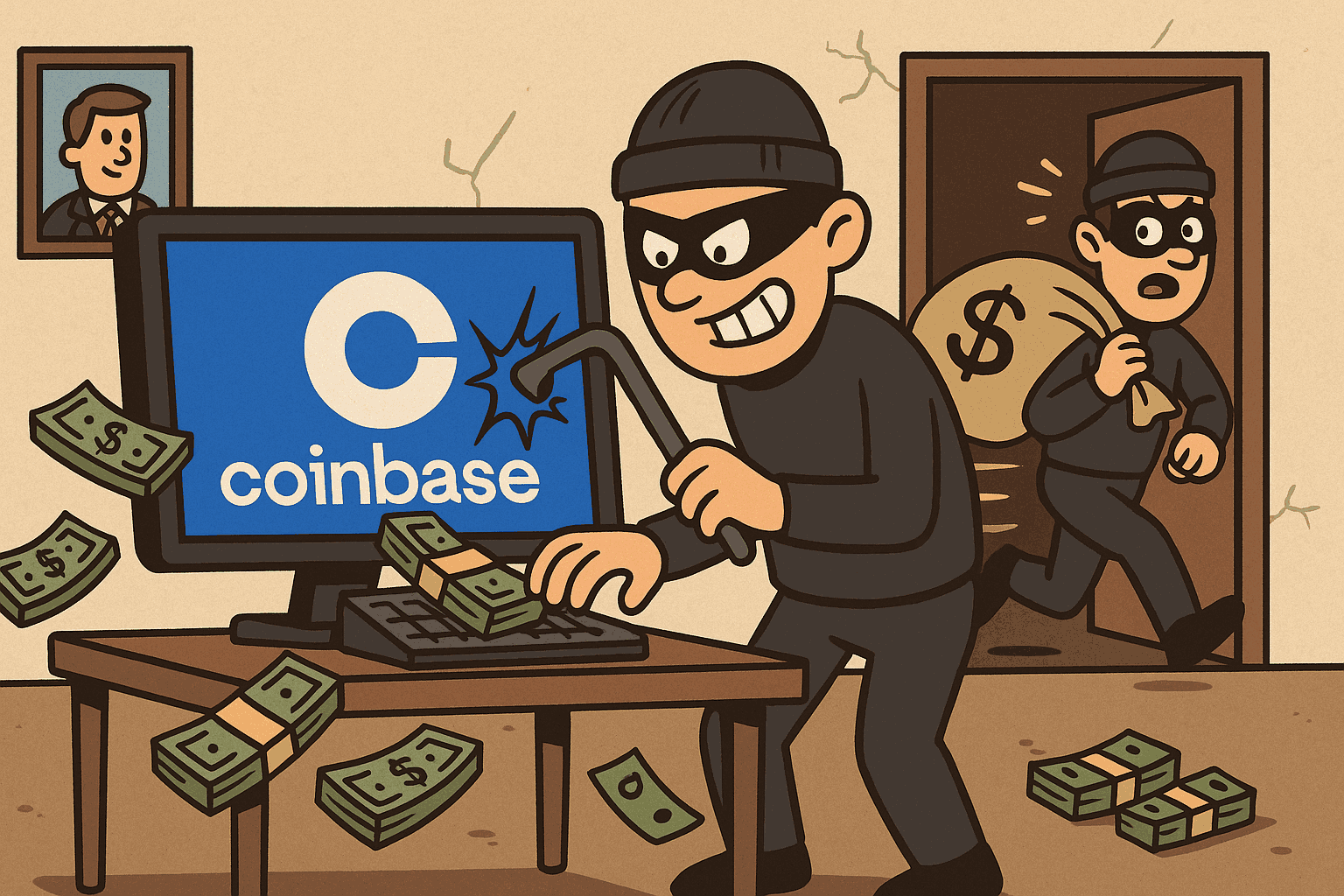Coinbase Hacking: How the May 2025 Breach Happened and Lessons Learned

In May 2025, Coinbase one of the world’s largest cryptocurrency exchanges – suffered a significant security breach that sent shockwaves through the crypto community. This incident involved a sophisticated social engineering attack exploiting insider access, rather than a direct technical hack of blockchain systems. Below, we break down how the breach occurred, what information was compromised, the implications for users of centralized exchanges (CEXs), and key lessons on securing custodial assets. Newer Web3 users can learn from this event about the importance of security and trust in crypto platforms, especially in contrast to decentralized models.
How the Breach Occurred: An inside job
Coinbase revealed that cybercriminals bribed and recruited a small number of overseas customer support agents to gain unauthorized access to exchange systems. By leveraging these rogue insiders, the attackers were able to copy sensitive customer data from Coinbase’s support databases. In essence, rather than breaching the exchange’s code or servers directly, the hackers manipulated human vulnerabilities – a classic social engineering tactic. They reached out to certain support staff, offering money in exchange for confidential data. Unfortunately, a handful of contractors and employees fell for this scheme and abused their customer support privileges to siphon out user information.
This coordinated insider attack was first detected around May 11, 2025, when an unknown actor emailed Coinbase claiming to have stolen customer account data and internal documents. Coinbase’s investigation confirmed that a subset of customer records had indeed been compromised. Notably, no technical vulnerability in Coinbase’s platform was exploited – instead, the breach was enabled by malicious insiders acting on behalf of the attackers. This highlights that even the most technologically secure platform can be undermined by human factors if proper controls aren’t in place.
What Was Compromised (and what wasn’t)
Crucially, the breach did not expose user passwords, private keys, or the ability to directly access funds, according to Coinbase’s public incident report. In other words, the attackers did not obtain the keys needed to move crypto out of customer accounts, and they could not log in to accounts using passwords or two-factor authentication codes. Coinbase’s cold wallets and vaults also remained secure. This meant that—unlike some past exchange hacks—no cryptocurrency was immediately stolen by the hackers themselves during the breach.
However, the personal data compromised was extensive and highly sensitive. According to reports, the stolen information included full names, home addresses, email addresses, and phone numbers of customers. Even more worryingly, the hackers obtained images of government-issued IDs (such as driver’s licenses or passports) that customers had submitted for KYC verification. They also accessed partial financial data (like masked bank account numbers), as well as account details like users’ transaction histories and potentially their crypto account balances. In short, the attackers got a list of thousands of Coinbase customers, how to contact them, and an idea of how much crypto they hold.
This combination of personal identifiable information (PII) and crypto holdings is extremely dangerous. Even though the attackers couldn’t directly steal funds via the breach, having this data allowed them (or others) to target users through phishing scams, impersonation, or even physical threats. Indeed, Coinbase indicated the hackers’ primary aim was to collect a customer list they could impersonate Coinbase to essentially to trick users into handing over their crypto through follow-up scams. Shortly after the breach, some affected users reported fake calls or emails from people posing as Coinbase support, urging them to “secure” their funds in a scam wallet.
The severity of the leaked data also raised alarms about personal safety. TechCrunch founder Michael Arrington warned that exposing identities and balances of crypto holders could “lead to deaths”, referencing recent cases where wealthy crypto owners were kidnapped or assaulted by criminals. For example, knowing a specific individual’s address and that they have a large Bitcoin balance could embolden violent extortion attempts. This aspect makes the Coinbase breach not just a cybersecurity issue, but a physical security risk for the crypto community.
Aftermath and Impact on Users
Upon discovering the breach, Coinbase took several steps to manage the fallout and protect its users. All affected customers (approximately under 1% of Coinbase’s monthly users) were notified by Coinbase via email on May 15, right after the incident was confirmed. Coinbase promised to reimburse any customer who unknowingly fell victim to the scammers – for instance, if someone was tricked into sending funds to the attackers due to the impersonation attempts, Coinbase would cover their loss. This commitment is significant, as the potential liability was large: Coinbase estimated the incident could cost the company between $180 million and $400 million in total. This range likely included reimbursements, investigative costs, security upgrades, and potential legal liabilities. (A class-action lawsuit was indeed filed, alleging Coinbase failed to adequately safeguard user data.)
Meanwhile, the attackers attempted to extort Coinbase for a $20 million ransom, threatening to release or sell the stolen data if not paid. Coinbase’s leadership refused to pay. Instead, in a dramatic counter-move, the company publicly offered a $20 million bounty for information leading to the hackers’ arrest. Coinbase also immediately fired the rogue support contractors involved and reported them to law enforcement in the U.S. and abroad. As of the latest updates, government agencies (including the U.S. Justice Department) have an active investigation, with Coinbase actively cooperating.
For users, beyond the financial impact, this breach has understandably shaken trust in centralized exchanges. Many customers were shocked that their personal documents and addresses could be exposed in a crypto hack, since they might have assumed crypto hacks only involve stealing coins. It was a wake-up call that using a centralized service means entrusting not just your money but also your sensitive personal info to that company’s defenses. Unlike a decentralized protocol, a CEX typically requires full identity verification, creating a honeypot of private data that, if compromised, can have far-reaching consequences. This incident highlighted that the risks of a CEX are not limited to losing funds from an exchange wallet hack – privacy breaches are another serious concern.
Notably, Coinbase’s stock (COIN) was set to join the S&P 500 index around the same time, yet news of the breach and potential $400M loss caused some investor concern. The timing underscored how security events can even influence market perceptions and regulatory scrutiny. In fact, shortly after, reports emerged that the U.S. SEC was examining whether Coinbase’s user data protections were adequate and if any regulatory missteps occurred. Even though Coinbase denied wrongdoing, the breach invited regulators to ask hard questions about compliance, insider threat management, and data security standards for crypto firms.
What the Industry Learned: Securing Custodial Assets and Data
The Coinbase hack of May 2025 underscores several key lessons for the crypto industry, especially custodial platforms:
- Limit Insider Access & Strengthen Controls: Exchanges must re-evaluate how much access customer support and other staff have to sensitive data. Following the breach, Coinbase opened a new U.S.-based support center and implemented stricter controls/monitoring on support agents globally. This includes background checks, insider-threat detection systems, and principles of least privilege (only granting employees the minimum data access needed). Regular audits and “red team” simulations can help find internal vulnerabilities. Other exchanges will likely follow suit, realizing that human weaknesses can undo even robust system security.
- Secure Personal Data (or Don’t Collect So Much): This incident has sparked debate about how much user data custodians should hold. Under current regulations, exchanges must collect KYC information (government IDs, etc.), but perhaps they can leverage better encryption, shorter data retention, or privacy-preserving techniques. Some in the community advocate for decentralized identity frameworks or zero-knowledge proofs to verify user identities without storing large databases of real names and addresses. (For example, using a zk-proof to confirm someone meets compliance requirements, without revealing their actual ID info.) The combination of KYC laws and big centralized databases is risky – as Arrington noted, it creates a dangerous situation where users’ identities are exposed. Going forward, custodial providers might explore innovative solutions to minimize stored PII or keep it off-line to reduce the fallout of any breach.
- User Education – Beware Social Engineering: Coinbase’s follow-up advice to users emphasized vigilance against imposters. Users should distrust unsolicited calls/emails claiming to be from exchanges and never share passwords or 2FA codes. Scammers may use personal info to sound convincing (“we know your account balance, so we’re legit”), but users must verify communication through official channels. As a rule, no real Coinbase employee will ever ask for your private keys or ask you to send funds out – any such request is a red flag. Enabling features like withdrawal address whitelisting (so funds can only go to pre-approved wallets) can provide an extra safety net. The industry at large sees that continuous customer education is vital; even the best platform security fails if a user is tricked into voluntarily sending their coins to a thief.
- Custodial vs. Non-Custodial Trade-Off: More broadly, the breach reignited discussion of using decentralized exchanges (DEXs) and self-custody. On a DEX, users trade directly from their personal wallets without handing over personal documents or funds to a central party. This means there is no centralized trove of user data to hack. Many in the Web3 community have long touted the mantra “Not your keys, not your coins,” and incidents like this Coinbase hack bolster the case for self-custody of assets whenever feasible. However, decentralized platforms come with their own risks (smart contract bugs, no customer support, etc.), so the choice must be made carefully. A hybrid approach can be using CEXs for convenience but withdrawing funds to personal wallets for longer-term holding, thereby limiting exposure. Cross-chain security principles that Mitosis emphasizes – such as distributing trust and avoiding single points of failure can analogously be applied here: relying solely on one centralized entity concentrates risk.
In response to the breach, Coinbase and other exchanges are likely to adopt much stricter security standards, closer to traditional banks. This includes physical security for data centers, surveillance on staff actions, and perhaps multi-person approval processes for accessing sensitive data (to prevent one rogue agent acting alone). The industry might also consider insurance and compensation funds to cover users in the event of breaches, as a way to bolster confidence.
Conclusion
The May 2025 Coinbase hacking incident was a stark reminder that even trusted institutions in crypto are not immune to old-fashioned schemes. For new Web3 users, it highlights the importance of understanding how your chosen platform secures both your assets and your personal information. While Coinbase’s response reimbursing victims, refusing to succumb to extortion, and improving security set a strong example, prevention is always better. The crypto community learned to double-down on security culture: from the companies (implementing robust safeguards and transparency) to the users (staying alert to scams and possibly exploring self-custody solutions). In an ecosystem often defined by decentralization, this breach demonstrated the risks of centralization in very human terms. By learning from such incidents and continuously improving, the industry can aim to better align with the ethos of crypto empowering users without compromising their safety.



Comments ()